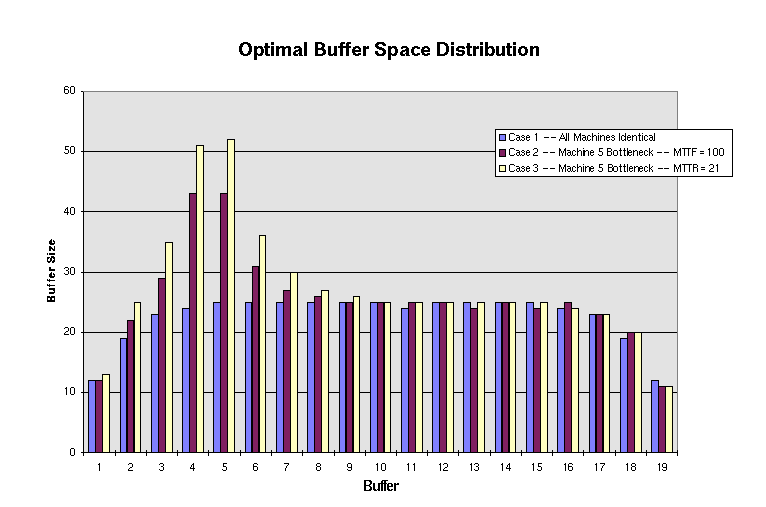Click HERE
to go to the Leaders for Manufacturing Research Group 5 Home Page.
How to design a production line that has a bottleneck

Problem: suppose we are designing a 20-machine production line.
The machines have been selected, and the only decision remaining is
the amount of space to allocate for in-process inventory. The common
operation time is one operation per minute. The target production
rate is .88 parts per minute. The goal is to determine the
smallest amount of in-process inventory space so that the line meets
that target.
Three production lines have been optimized in the figure. That is, we
have found the minimal total inventory space required to produce .88
parts per minute for three different lines. The figure displays how
that space is distributed.

In Case 1, each machine is unreliable with mean time to fail (MTTF)
200 minutes and mean time to repair (MTTR) 10.5 minutes. Every
machine could therefore operate in isolation at rate .95 parts per
minute on the average, and easily meet the target. However, if there
were no in-process inventory allowed, each machine's failure would
cause every other machine to be forced idle, and the actual production
rate would only be .487. To achieve the target production rate, the
minimal required inventory space is room for 430 parts, distributed
according to the figure.
Case 2 and 3 are similar to Case 1, except that Machine 5 (and
only Machine 5) is replaced by a less reliable model. In both cases,
the reliability of Machine 5 is reduced to .905. In Case 2, MTTF =
100 and MTTR = 10.5 minutes; In Case 3, MTTF = 200 and MTTR = 21
minutes. There is thus a well-defined bottleneck.
With no buffering between the machines, the production rate of both
Cases 2 and 3 would be .475. Again, each machine (including the
bottleneck) could meet the required production rate in isolation, but
the complete system cannot without inventory buffering between the
machines. The minimal required total inventory space is room for 485
parts for Case 2 and 523 for Case 3.
Summary
| Line |
Production rate with no buffers |
Minimal buffer space for production rate target (.88 parts/min) |
| Case 1 |
.487 |
430 |
| Case 2 |
.475 |
485 |
| Case 3 |
.475 |
523 |
Observations:
- The additional inventory space is allocated approximately
symmetrically around the bottleneck, but it is not all placed
precisely at the bottleneck.
- Case 3 needs more space than Case 2. This suggests that increased
repair time is worse than increased failure frequency.
- Case 1 exhibits the inverted bowl phenomenon, observed by
Hillier, So, and Boling (1993). A line with identical machines
requires less buffer space at the ends because of the usual assumption
that the first machine is never starved and the last machine is never
blocked.
- Especially sharp-eyed readers may notice that the graphs look a
little uneven. This is due mainly to the fact that we have restricted
the solution to integers: we are assuming that the line is producing
discrete items. In addition, the results shown may be slightly
non-optimal.
Note:The zero-buffer production rates were calculated from
the work of Buzacott (1968). The optimal distributions of buffer
space were calculated from Gershwin and Goldis (1995) and Schor
(1995).
References:
J. A. Buzacott (1968), ``Prediction of the Efficiency of Production
Systems without Internal Storage,'' Int. J. Prod. Res., Vol. 6,
No. 3, pp. 173-188.
S. B. Gershwin and Y. Goldis (1995), ``Efficient Algorithms for
Transfer Line Design,'' MIT Laboratory for Manufacturing and
Productivity Report LMP-95-005, November, 1995, 50 pages.
F. S. Hillier, K. C. So, and R. W. Boling (1993), ``Toward
Characterizing the Optimal Allocation of Storage Space in Production
Line Systems with Variable Processing Times,'' Management
Science, Volume 39, Number 1, January, 1993, pp. 126-133.
James E. Schor (1995), ``Efficient Algorithms for Buffer Allocation,''
M.S. Thesis, MIT EECS; MIT Laboratory for Manufacturing and
Productivity Report LMP-95-006, May, 1995.
Copyright © Massachusetts Institute of Technology 1996.
All rights reserved.


